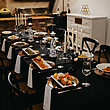
The most fun way to celebrate a three-day weekend? With homemade ice cream, of course. “Scoop: 125 Specialty Ice Creams from the Nation’s Best Creameries” by Ellen Brown shares some of the best ice cream and sorbet recipes from the nation’s top shops. From Scottsdale’s very own Sweet Republic, here are two tasty summertime sweets.
Basil-Lime Sorbet
Makes about 1 quart
2 teaspoons unflavored gelatin or powdered agar
1 cup granulated sugar
Pinch of kosher salt
1 cup freshly squeezed lime juice
1/2 cup finely chopped fresh basil
1 tablespoon grated lime zest
Sprinkle the gelatin over 1/2 cup cold water to soften. Combine the sugar, salt, and 1 cup water in a saucepan, and bring to a boil over medium-high heat. Stir the softened gelatin into the pan. Cook for 1 minute, or until the gelatin dissolves. Remove the pan from the heat, and stir in 11/2 cups cold water, along with the lime juice, basil, and lime zest. Transfer the hot liquid to a storage container, and refrigerate uncovered until it is completely chilled (below 40ºF), or cool it according to the method (see below). Freeze the mixture in an ice cream maker according to the manufacturer’s instructions. Serve immediately for a soft sorbet, or transfer the mixture to an airtight storage container and freeze until hard. Allow the sorbet to sit at room temperature for 15 minutes before serving if frozen solid.
Avocado-Jalapeno Ice Cream
Makes about 1 quart
1 cup whole milk
1/2 cup heavy whipping cream
2 tablespoons nonfat dry milk powder
1 teaspoon kosher salt
3 large egg yolks
3 tablespoons granulated sugar
2 ripe avocados, peeled and diced
1/3 cup plain whole milk yogurt, preferably Greek-style, such as Fage
2 tablespoons freshly squeezed lime juice
1 to 2 jalapeño peppers, seeds and ribs removed, finely chopped
Combine the milk, cream, milk powder, and salt in a medium saucepan, and stir well to dissolve the milk powder. Bring the mixture just to a simmer, stirring occasionally. Beat the eggs yolks and sugar in a mixing bowl with a whisk until thick and light yellow in color. Slowly beat about one-third of the hot cream mixture into the eggs so they are gradually warmed up, and then return the contents of the mixing bowl to the saucepan. Place the pan over medium-low heat and stir constantly, reaching all parts of the bottom of the pan, until the mixture reaches about 170ºF on an instant-read thermometer; at this point it begins to emit steam, thickens slightly, and coats the back of a spoon. This takes 3 to 6 minutes. Do not allow the mixture to boil or the eggs will scramble. Strain the custard through a fine sieve, if desired. Transfer the hot liquid to a storage container and press a sheet of plastic wrap directly onto the surface of the mixture to prevent a skin from forming. Refrigerate the mixture uncovered until it is completely chilled (below 40ºF), or quick-cool it according to the method (see below). Combine 1 cup of the chilled custard with the avocados, yogurt, and lime juice in a food processor fitted with the steel blade or in a blender. Purée until smooth; transfer to a mixing bowl. Stir the remaining custard and chopped jalapeño into the avocado purée. Freeze the mixture in an ice cream maker according to the manufacturer’s instructions. Serve immediately for a soft ice cream, or transfer the mixture to an airtight storage container and freeze until hard. Allow the ice cream to sit at room temperature for 15 minutes before serving if frozen solid.
Cooling It Down
These recipes employ a time-honored, effective technique for cooling liquids properly: time. The first step is to pour the ice cream custard into a container and press a sheet of plastic wrap directly onto the surface of the hot liquid. This prevents the dairy solids from coagulating and forming a thick “skin.” When the custard reaches room temperature, you chill it to a temperature of between 38ºF and 40ºF by putting it on the top shelf of the refrigerator. And you preferably leave it overnight. This is called the “ripening” process in ice cream jargon.
But if you are in a hurry to get the machine going—it’s 6 p.m. and you want to serve the ice cream for dessert at 8 p.m.—you can go through a rather laborious cooling process. But the goal is that it must not be any hotter than 42ºF or the texture will not be smooth.
While the custard is heating, chill a metal mixing bowl in the freezer, and have a larger mixing bowl into which the chilled one will fit when the larger bowl is filled with ice. Then you’re going to replicate the environment of an old-fashioned cranked ice cream maker by placing ice cubes and salt in the larger bowl, and stirring the custard in the smaller bowl set over the ice until it has chilled. You must be careful, however, as the ice melts, that you do not inadvertently get salty ice water into the custard.
Recipes: Sweet Republic Ice Cream










